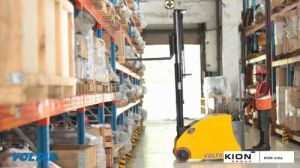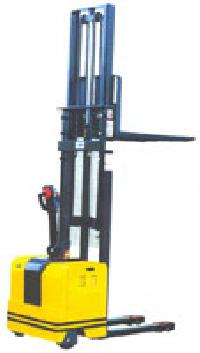
Mini Hand Stacker
30,700 - 48,599 Per piece
technical details on request .Mini Hand Stacker. Stacker is ideal for lifting and transporting loads in your shop or warehouse

ESW 15W Godrej Electric Stacker
Get Price Quote
Best Deals from Warehouse Stacker

Hydraulic Stacker
Get Price Quote
We are the main supplier of this product.

Double Mast Hydraulic Stacker
250,000 - 500,000 Per Set
1 Set(s) (MOQ)
As per the increasing and altering demands of our valued customers, we offer an innovatively designed and developed Double Mast Hydraulic Goods Lift to the clients.

Manual Hydraulic Stacker
Get Price Quote
1 Piece(s) (MOQ)
Buyers can order our products in bulk, as we maintain year around availability. In addition, we have reliable transportation system to make timely delivery. Our comprehensive range of products is packed in sturdy, safe, and industrial grade materials that safeguard the contents inside from harm, dampness, dust, movement etc. Besides, the packing has printed product information. Product Details: Capacity - 2000 kg Height -1940 mm Maximum Lifting height -1600 mm Fork length - 900 mm Stacker width - 600 mm fork height from the ground :85 mm.

Stacker Machine
Get Price Quote
A Stacker is a large machine used in bulk material handling. Its function is to pile bulk material such as limestone, ores and cereals on to a stockpile. A reclaimer can be used to recover the material. Stackers are nominally rated for capacity in tonnes per hour (tph). They normally travel on a rail between stockpiles in the stockyard. A stacker can usually move in at least two directions: horizontally along the rail and vertically by luffing (raising and lowering) its boom. Luffing of the boom minimises dust by reducing the distance that material such as coal needs to fall to the top of the stockpile. The boom is luffed upwards as the height of the stockpile increases. Some Stackers can rotate the boom. This allows a single stacker to form two stockpiles, one on either side of the conveyor. Stackers are used to stack in different patterns, such as cone stacking and chevron stacking. Stacking in a single cone tends to cause size segregation, with coarser material moving out towards the base. In raw cone ply stacking, additional cones are added next to the first cone. In chevron stacking, the stacker travels along the length of the stockpile adding layer upon layer of material. Stackers and reclaimers were originally manually controlled, with no means of remote control. Modern machines are typically semi-automatic or fully automated, with parameters remotely set. The control system used is typically a programmable logic controller, with a human-machine interface for display, connected to a central control system. Other than stacking, a stacker has three basic movements: Luffing: This is vertical movement. Stackers use either a winch mechanism with metal wire, or hydraulic cylinders, generally two. Winch mechanisms are highly reliable compared to hydraulic actuators and remain widely used, particularly in large stackers. Travelling: The stacker moves on a rail track, which may be broad or narrow gauge, enabling it to move around the stockyard as required. For this purpose, traction motors powered by direct current (DC) are connected by bevel gears to between 12 and 22 wheels. For manual control, all the controls are in a controller’s cabin above the boom conveyor or boom. Modern Stackers can be controlled remotely. Slewing: This is rotation of the stacker around its central axis to align or place the stockpile where required. This works mostly by a slew pinion that rotates around a slew base. This type of gear assembly is called a sun and planet gear. The axles may be multiple and are driven by DC-powered axle motors which transmit the torque via bevel orhelical gears.

Fully Electric Stacker
Get Price Quote

Cb Stacker
Get Price Quote

Stacker Machine
Get Price Quote
A Stacker is a large machine used in bulk material handling. Its function is to pile bulk material such as limestone, ores and cereals on to a stockpile. A reclaimer can be used to recover the material. Stackers are nominally rated for capacity in tonnes per hour (tph). They normally travel on a rail between stockpiles in the stockyard. A stacker can usually move in at least two directions: horizontally along the rail and vertically by luffing (raising and lowering) its boom. Luffing of the boom minimises dust by reducing the distance that material such as coal needs to fall to the top of the stockpile. The boom is luffed upwards as the height of the stockpile increases. Some Stackers can rotate the boom. This allows a single stacker to form two stockpiles, one on either side of the conveyor. Stackers are used to stack in different patterns, such as cone stacking and chevron stacking. Stacking in a single cone tends to cause size segregation, with coarser material moving out towards the base. In raw cone ply stacking, additional cones are added next to the first cone. In chevron stacking, the stacker travels along the length of the stockpile adding layer upon layer of material. Stackers and reclaimers were originally manually controlled, with no means of remote control. Modern machines are typically semi-automatic or fully automated, with parameters remotely set. The control system used is typically a programmable logic controller, with a human-machine interface for display, connected to a central control system. Other than stacking, a stacker has three basic movements: Luffing: This is vertical movement. Stackers use either a winch mechanism with metal wire, or hydraulic cylinders, generally two. Winch mechanisms are highly reliable compared to hydraulic actuators and remain widely used, particularly in large stackers. Travelling: The stacker moves on a rail track, which may be broad or narrow gauge, enabling it to move around the stockyard as required. For this purpose, traction motors powered by direct current (DC) are connected by bevel gears to between 12 and 22 wheels. For manual control, all the controls are in a controller’s cabin above the boom conveyor or boom. Modern Stackers can be controlled remotely. Slewing: This is rotation of the stacker around its central axis to align or place the stockpile where required. This works mostly by a slew pinion that rotates around a slew base. This type of gear assembly is called a sun and planet gear. The axles may be multiple and are driven by DC-powered axle motors which transmit the torque via bevel orhelical gears.

Full Electric Stacker
Get Price Quote
A prominent supplier of huge range of Full Electric Stacker.

Semi Electric Stacker
180,000 Per Piece

Hand Stacker
Get Price Quote
Suitable for light stacking applications in confined areas and stores, the Safelift hand stacker has load capacities up to 2000 Kgs.

Straddle Trucks
450,000 Per Piece

Magnetic Stacker Machine
Get Price Quote

pallet stackers
Get Price Quote
battery platform trucks, Pallet Truck, material lifting floor cranes

Stacker Reclaimer
Get Price Quote
Stacker Reclaimer, level luffing cranes, Ship Loader

battery stacker
Get Price Quote
battery stacker, 24 Volt Connector, Straddle Type Stacking Truck

Stacker Machine
Get Price Quote
Josts material handling division is committed to provide innovative material handing solutions for internal material handling needs of its customers to improve the efficiency of their processes.

Electric Stacker
Get Price Quote
Electric Stacker, Electric Stacker, label applicators, Strapping Machines

stacker reclaimers
Get Price Quote
stacker reclaimers, unloader, l crane